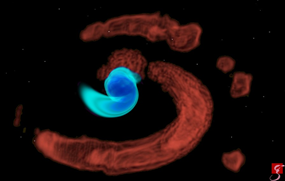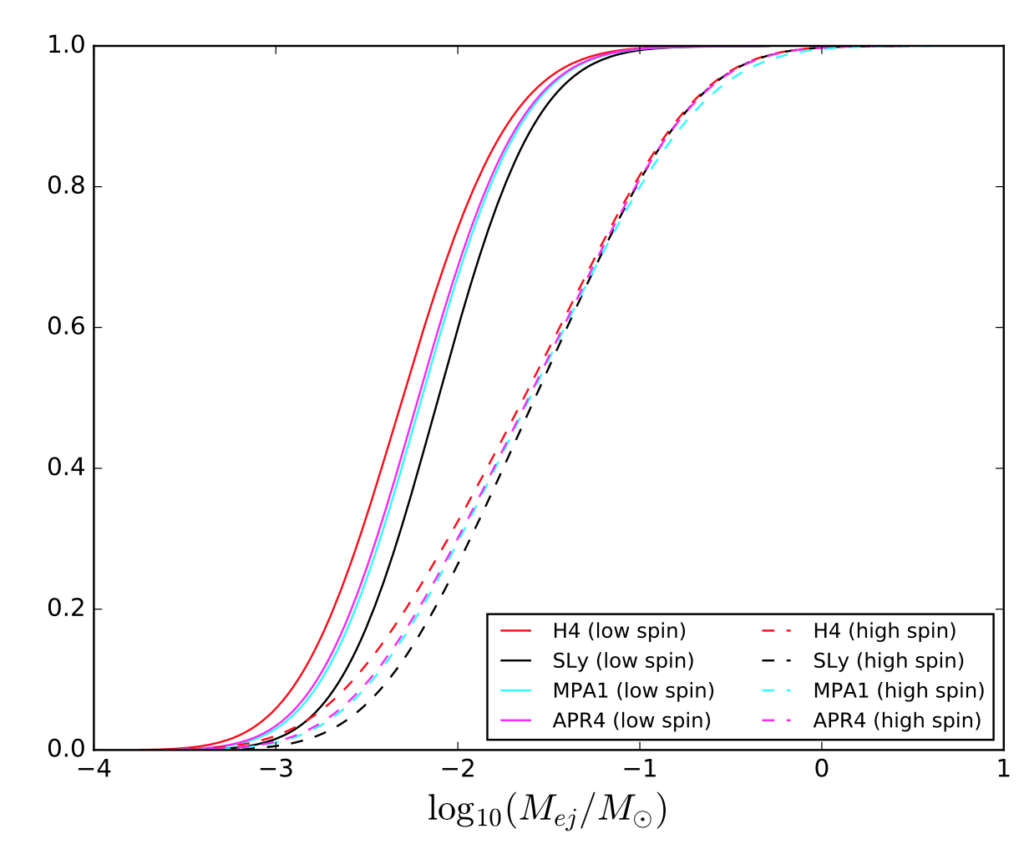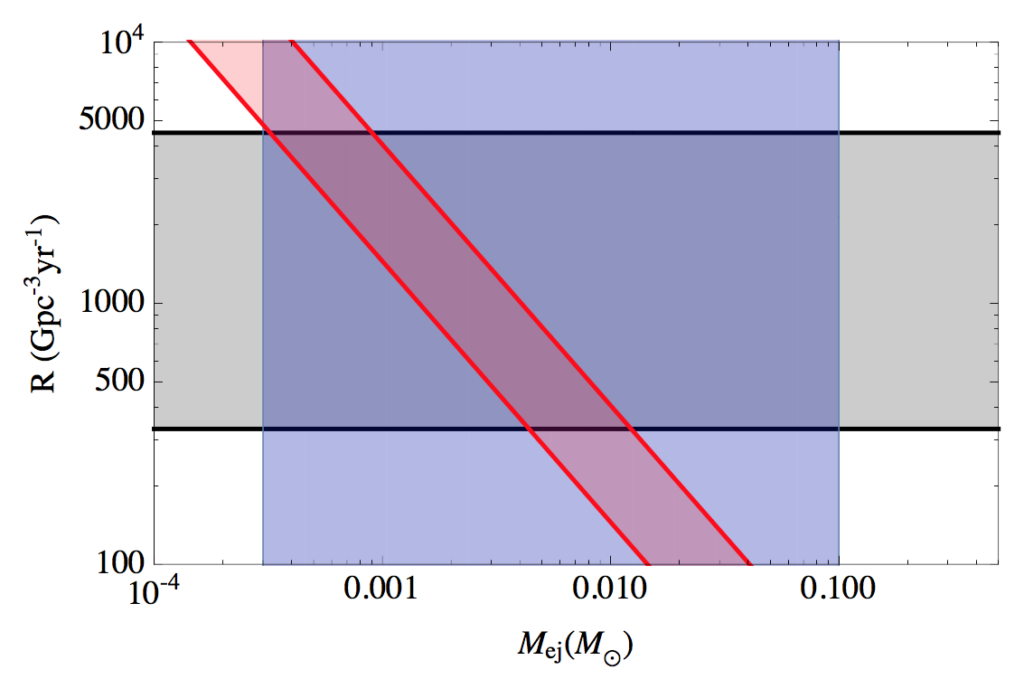The source of the gravitational-wave signal GW170817, very likely a binary neutron star merger, was also observed electromagnetically, providing the first multi-messenger observations of this type. In this paper, we consider the matter that is flung out of the system as the two neutron stars merge. This ejected matter is predicted to undergo r-process nucleosynthesis and create a bright glow, called a kilonova and such a glow was in fact observed by astronomers. We can also learn about this ejected matter from the gravitational-wave data alone using models calibrated to neutron-star-merger simulations. Specifically, we apply these models to the binary masses inferred from the GW170817 measurements to determine the amount of matter ejected dynamically, i.e. flung out during the merger. The distributions of dynamical ejecta mass for GW170817 range between one-thousandth and one-hundredth the mass of the sun. The amount of matter ejected is then used to estimate its contribution to the corresponding brightness and color evolution of the kilonova. In addition, we use our estimates of the dynamical ejecta mass and the neutron star merger rates inferred from GW170817 to constrain the contribution of events like this to the abundances of heavy elements like gold in our universe.

A simulation of the merger of two neutron stars with masses consistent with those of GW170817. Credit: T. Dietrich, S. Ossokine, H. Pfeiffer, A. Buonanno/Max Planck Institute for Gravitational Physics/BAM Collaboration
The detection of GW170817 from the merger of two neutron stars (NS) stands in contrast to the previous gravitational-wave (GW) detections of black holes, since it involves not only the physics of curved spacetime, but also that of dense matter. In particular, the neutron-rich matter involved in the NS collision can produce an electromagnetic counterpart. Some of this matter is expected to be ejected from the system during the merger and undergo what is known as r-process nucleosynthesis. As the matter ejected from the NS merger undergoes nuclear reactions, it glows brightly. Such a glow, typically called a “kilonova“, was observed by multiple teams of astronomers for GW170817 (for more information about these observations, see the science summary for the multi-messenger astronomy campaign). Using only gravitational-wave data from GW170817, we are able to put constraints on the properties of the ejected mass which astronomers can compare with their electromagnetic (EM) observations.
Estimating the mass of the ejecta
One can predict the amount of matter ejected during a neutron star merger using numerical simulations that solve the Einstein equations describing curved spacetime together with the relativistic hydrodynamic equations describing the matter in the neutron stars (and possibly also further equations describing magnetic fields or neutrinos). These simulations show that the ejecta depends on many parameters, but for the type of ejecta we consider, most notably the masses of the two stars, as well as their sizes and how strongly their matter is bound to them by their own gravity. Specifically, it depends on the stars’ compactness — how large they are for a given mass — and their binding energies — the amount of energy necessary to disassemble the star completely. We use a fitting formula that gives the mass of the ejecta in terms of these properties of the stars in the binary and is calibrated to the results of over a hundred numerical simulations of binary neutron star coalescences. These predictions only consider the matter ejected dynamically, i.e. matter flung out from the system during its violent merger. Additional matter may be ejected on longer timescales after the merger by winds from a disk of matter around the merger remnant. However, this is not included in the simulations, so we do not consider it here.
The masses of the neutron stars in the binary can be inferred from the gravitational wave observations. The stars’ compactnesses and binding energies can be inferred from their masses by using an equation of state describing the large-scale behavior of the matter in the neutron star (see the detection paper science summary for more details). Since the matter in neutron stars is much denser than any matter we can study on Earth (except for fleeting particle collisions), this equation of state is uncertain. We thus consider a range of theoretical predictions. Alternatively, we can use the gravitational wave measurements of the tidal deformabilities of the neutron stars to infer the stars’ compactnesses and binding energies using fits calibrated to a wide range of equations of state. As discussed in the detection paper science summary, the tidal deformabilities tell us how much the star deforms in response to its companion’s gravitational field, and thus about their internal structure.

Figure 1: These curves show the probability (y-axis) that the matter flung out from the system is at least as much mass shown on the x-axis. The solid curves assume that the neutron stars that collided were barely (if at all) spinning, and the dashed curves allow the possibility of neutron star with higher spins. The colors denote different assumptions about the neutron stars’ compactnesses and binding energies. In the low-spin case, no more matter is ejected than about one-hundredth mass of the sun.
Light curves
Depending on how, and how much, mass is ejected from the NS system, the kilonova will exhibit a different EM spectrum. We employ three different models to compute possible optical and near-infrared signals (called light curves) that might be observed given our inference of the ejecta mass. Astronomers who have made EM observations of the GW170817 kilonova can compare their observations to these predictions in order to test those models and to test the hypothesis that matter is only ejected dynamically. With GW170817, we are for the first time ever be able to do such comparisons, opening up the field of multi-messenger astronomy.

Figure 2: Light curves show how much light we see on Earth produced by the mass flung out from the neutron star merger. Each panel shows the source’s predicted brightness (y-axis) at a given time (x-axis) for a different color of light observed in our telescopes (a “filter”). The panels are ordered from blue/green filters at the top to near-infrared filters at the bottom. (This is Figure 3 in our publication)
The r-process
The rapid neutron capture process, or r-process, is one channel through which elements heavier than Iron can be created, and it has been suggested that previous NS mergers could have been the source of the r-process elements we see in the galaxy today, including all the ones we have here on Earth. Supernovae are also expected to contribute to these abundances, though it is unknown if supernovae or NS mergers are the dominant r-process site. If NS mergers are to account for all the r-process elements observed, they must eject substantial r-process matter and have a relatively high rate of occurrence in the Universe. From our GW data on GW170817, we get constraints on both the ejecta mass and the NS merger rate, which can then be used to estimate the NS merger contribution to r-process abundances. Assuming that all NS mergers have properties like those inferred from GW170817, we find that if >~10% of the dynamically ejected mass is converted to r-process elements, NS mergers could account for all the observed r-process abundances. Future observations of GWs from NS mergers will help solve the longstanding mystery of where the majority of r-process elements are created.

Figure 3: This plot shows that that neutron star mergers could be a dominant site of production of certain heavy elements. The y-axis shows how often neutron star mergers occur (the “rate” of mergers), and the x-axis is how much mass is flung out of (ejected from) neutron star merger systems like GW170817. The gray band shows the rates inferred from GW170817, and the blue band shows what astronomers think are plausible ejected mass values given that we discover bright sources with telescopes. The red band, in the overlapping region, shows the possible cases where neutron star mergers could account for all the r-process elements observed in the solar system. The overlap of the three bands shows that neutron star mergers could plausibly be the dominant source of r-process elements given our data on GW170817. (This is Figure 5 in our publication)
Find out more
- Visit our websites: http://ligo.org ; http://www.virgo-gw.eu
- You can read the full article, which has been accepted for publication in Astrophysical Journal Letters, here.
- Multi-messenger Observations of a Binary Neutron Star Merger
- GW170817: Observation of gravitational waves from a binary neutron star inspiral
- Gravitational Waves and Gamma Rays from a Binary Neutron Star Merger: GW170817 and GRB 170817A
- A gravitational-wave standard siren measurement of the Hubble constant with GW170817
- Search for post-merger gravitational waves from the remnant of the binary neutron star merger GW170817
- On the Progenitor of Binary Neutron Star Merger GW170817
- GW170817: Implications for the Stochastic Gravitational-Wave Background from Compact Binary Mergers
- Search for High-energy Neutrinos from Binary Neutron Star Merger GW170817 with ANTARES, IceCube, and the Pierre Auger Observatory

